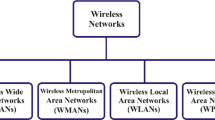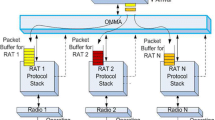Abstract
The exploitation of the 60 GHz band is a very promising approach to fulfill the rapidly increasing data rate requirement of wireless indoor communication. One important 60 GHz application is the short-range point-to-point data transmission with Ultra-High-Rate (UHR, up to 10 Gbps) (Krone et al. in International Journal of Microwave and Wireless Technologies, 2011, 189–200). The design of such high data rate systems is very challenging. Except for Analog-Front-End (AFE) and physical layer (PHY) designs, the Medium Access Control (MAC) layer design is also crucial for the achievable system throughput. Among the MAC functionalities, the acknowledgment (ACK) mechanism is a very important component affecting the transmission efficiency and reliability. In this paper, a Hybrid Dynamic Frame Aggregation and Block-Acknowledgment (HD-FABA) scheme is proposed, which enables large-scale frame aggregation and can achieve significant ACK overhead reduction compared to the existing schemes. A theoretical model is developed for throughput analysis, which is verified by packet-level simulation. Both theoretical- and simulation results show that the HD-FABA scheme allows a number of MAC parameters to be optimized according to the PHY conditions (e.g. BER), leading to much higher throughput than with the state-of-the-art scheme.
Similar content being viewed by others
Abbreviations
- ACK:
-
Acknowledgment
- AFE:
-
Analog frontend
- AMB:
-
Aggregated MAC Block
- BUF:
-
Buffer
- Dly:
-
Delayed
- ECC:
-
Error correction code
- FRAG:
-
Fragment
- FCS:
-
Frame check sequence
- FH:
-
Frame header
- HCS:
-
Header check sequence
- HD-FABA:
-
Hybrid dynamic frame aggregation and block acknowledgment
- LOS:
-
Line of sight
- LSF:
-
Last subframe (of a PHY frame)
- MAC:
-
Medium access control
- MH:
-
MAC header
- MIFS:
-
Minimum inter-frame space
- MPDU:
-
MAC protocol data units
- MSDU:
-
MAC service data units
- NAK:
-
Not acknowledged
- PF:
-
Physical layer frame
- PH:
-
PHY header
- PHY:
-
PHYsical layer
- PR:
-
Preamble
- Rq:
-
Request
- SEQ:
-
Sequence (number)
- SIFS:
-
Short inter-frame space
- SF:
-
Subframe
- SH:
-
Subheader
- TDD:
-
Time division duplex
- UHR:
-
Ultra-high-rate
- B :
-
Number of AMBs used for the dynamic AMB size modeling
- c H :
-
Repetition number of the Blk-ACK payload
- c BA :
-
Repetition number of the headers (MH, SH)
- M AG :
-
Number of SFs in an AMB
- M AG, b :
-
Number of SFs in the bth AMB
- M B,b :
-
Number of SFs in the sink BUF
- M BUF :
-
Maximum allowable number of SFs in the BUF
- M E,b :
-
Number of buffered and retransmitted SFs related to the bth AMB
- M P :
-
Number of SFs within an ordinary PHY-frame
- M R,b :
-
Number of retransmitted SFs in the bth AMB
- M N,b :
-
Number of new SFs in the bth AMB
- N BMAP :
-
Number of bits in the Blk-ACK bitmap
- N BUF :
-
The sink BUF size in bits
- N FCS :
-
Number of bits in the FCS
- N HCS :
-
Number of bits in the HCS
- N M :
-
Maximum allowable number of a missing Blk-ACK
- N MH :
-
Number of bits in the MH (incl. HCS)
- N OF :
-
Number of bits in other fields of the Blk-ACK payload
- N PH :
-
Number of bits in the PH
- N PL :
-
Maximum number of bits in PHY-frame payload
- N PL,BA :
-
Number of bits in Blk-ACK payload
- N S :
-
Expected number of correctly received MAC payload bits within an AMB
- N SF :
-
Number of bits in the SF (incl. FCS)
- N SF,C :
-
Mean value of correctly received bits in each SF
- N SFN :
-
Number of bits in the “Number of SFs” field in SH
- N SH :
-
Number of bits in the SH (incl. HCS)
- N SHF :
-
Number of bits in the “SH field” in SH
- P AB :
-
Probability that both ACK-Rq and Blk-ACK are correctly received
- P AR :
-
Probability that the ACK-Rq is correctly received
- p BA :
-
Error probability of the Blk-ACK
- P H :
-
Probability that all headers are correctly detected
- p MH :
-
MH error probability
- p PH :
-
PH error probability
- p PL,BA :
-
Error probability of the Blk-ACK payload
- p PR :
-
Mis-detection probability of the preamble
- p R,b :
-
Probability that error occurs in at least one retransmitted SF of the bth AMB
- p SF :
-
SF error probability
- p SH :
-
SH error probability
- p SH,L :
-
Error probability of the SH in the last PHY-frame
- T A :
-
Expected transmission duration of an AMB including the ACK process
- T ACK :
-
Mean duration of the ACK process
- T b :
-
Bit duration of the PHY-frame payload in ns
- T BA :
-
Duration of the Blk-ACK frame
- T MH :
-
Duration of MH in ns
- T PH :
-
Duration of PH in ns
- T SH :
-
Duration of SH in ns
- T SF :
-
Duration of SF in ns
References
Krone, S., Guderian, F., Fettweis, G., Petri, M., Piz, M., Marinkovic, M., et al. (2011). Physical layer design, link budget analysis, and digital baseband implementation for 60 GHz short-range applications. International Journal of Microwave and Wireless Technologies, 2 189–200.
Peter, M., Keusgen, W., & Luo, J. (2008). A survey on 60 GHz broadband communication: Capability, applications and system design. In European Microwave Week 2008, Amsterdam, pp. 1–4.
Schulte, B., Peter, M., Felbecker, R., Keusgen, W., Steffen, R., Schumacher, H., et al. (2011). 60 GHz WLAN applications and implementation aspects. EuMA International Journal of Microwave Wireless Technology (special issue on 60 GHz communication systems), 3, 213–221.
German project “EASY-A”: Enablers for Ambient Services & Systems, Teil A—60 GHz Breitbandverbindungen, http://www.easy-a.de.
Langer, K., & Vucic, J. (2010). Optical wireless indoor networks: Recent implementation efforts. In 36th European conference and exhibition on, optical communication (ECOC) pp. 1–6.
Wang K., Nirmalathas A., Lim C., Skafidas E.: High-speed optical wireless communication system for indoor applications. IEEE, Photonics Technology Letters 23(8), 519–521 (2011)
Ulusoy, A. C., Liu, G., Peter, M., Felbecker, R., Abdine, H. Y., & Schumacher, H. (2010). A BPSK/QPSK receiver architecture suitable for low-cost ultra-high rate 60 GHz wireless communications. In European microwave conference (EuMC).
Ulusoy, A. C., & Schumacher, H. (2011). A system-on-package analog synchronous QPSK demodulator for ultra-high rate 60 GHz wireless communications. In International microwave symposium, Baltimore.
Xiao Y., Shen X., Jiang H.: Optimal ACK mechanisms of the IEEE 802.15.3 MAC for ultra-wideband systems. IEEE Journal on, Selected Areas in Communications 24(4), 836–842 (2006)
Liu K.-H., Rutagemwa H., Shen X., Mark J.: Efficiency and goodput analysis of Dly-ACK in IEEE 802.15.3. IEEE Transactions on, Vehicular Technology 56(6), 3888–3898 (2007)
Lee I.-G., Yoon S.-R., Park S.-C.: Throughput analysis of ieee 802.11e wireless LANs and efficient block ack mechanism. IEEE International Symposium on Communications and Information Technology (ISCIT) 1, 290–295 (2004)
Li T., Ni Q., Xiao Y.: Investigation of the block ACK scheme in wireless ad-hoc networks. Wireless Communications and Mobile Computing 6, 877–888 (2006)
Pyo, C. W., Lan, Z., Kojima, F., Harada, H., & Kato, S. (2008). MAC enhancement for gbps throughput achievement in millimeter-wave wireless PAN systems. In International wireless communications and mobile computing conference pp. 189–194.
IEEE P802.15.3c/D08 Part 15.3: Wireless MAC and PHY specifications for high rate wireless personal area networks (WPAN): Amendment 2: Millimeter-wave based Alternative PHY extension, Std., March 2009.
Singh, H., Yong, S.-K., Oh, J., & Ngo, C. (2009). Principles of IEEE 802.15.3c: Multi-gigabit millimeter-wave wireless PAN. In Internatonal conference on computer communications and networks (ICCCN) pp. 1–6.
Luo, J., Kortke, A., & Keusgen, W. (2010). Throughput maximization of a hybrid dynamic frame aggregation and block-ACK scheme for 60 GHz high speed communications. In IEEE 21st international symposium on personal, indoor and mobile radio communications (PIMRC).
Kojima, F., Pyo, C.-W., Lan, Z., Harada, H., Kato, S., & Nakase, H. (2007). Necessary modifications on conventional IEEE802.15.3b MAC to achieve IEEE802.15.3c millimeter wave WPAN. In IEEE 18th international symposium on personal, indoor and mobile radio communications (PIMRC) 2007 pp. 1–5.
Bianchi G.: Performance analysis of the IEEE 802.11 distributed coordination function. IEEE Journal on, Selected Areas in Communications 18(3), 535–547 (2000)
Author information
Authors and Affiliations
Corresponding author
Rights and permissions
About this article
Cite this article
Luo, J., Kortke, A. & Keusgen, W. An Efficient Frame Aggregation and Block-ACK Scheme for 60 GHz Short-Range Point-to-Point Transmission. Wireless Pers Commun 69, 53–73 (2013). https://doi.org/10.1007/s11277-012-0560-3
Published:
Issue Date:
DOI: https://doi.org/10.1007/s11277-012-0560-3




